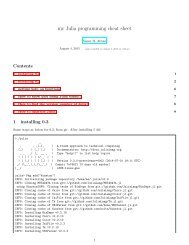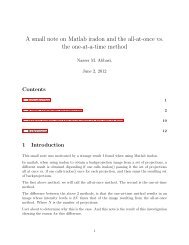You also want an ePaper? Increase the reach of your titles
YUMPU automatically turns print PDFs into web optimized ePapers that Google loves.
The input is the following.<br />
1. µ 1 planet one standard gravitational parameter<br />
2. µ 2 planet two standard gravitational parameter<br />
3. µ sun standard gravitational parameter for the sun 1.327 × 10 8 km<br />
4. r 1 planet one radius<br />
5. r 2 planet two radius<br />
6. alt 1 original satellite altitude above planet one. For example, for LEO use 300 km<br />
7. alt 2 satellite altitude above second planet. (since goal is to send satellite for circular orbit around second<br />
planet)<br />
8. R 1 mean distance of center of first planet from the sun. For earth use AU = 1.495978 × 10 8 km<br />
9. R 2 mean distance of center of second planet from the sun. For Mars use 1.524 AU<br />
10. SOI 1 sphere of influence for first planet. For earth use 9.24 × 10 8 km<br />
11. SOI 2 sphere of influence for second planet.<br />
Given the above input, there are the steps to achieve the above maneuver<br />
1. Find the burn out distance of the satellite r bo = r 1 + alt 1<br />
2. Find satellite speed around planet earth (relative to planet) V sat =<br />
√<br />
µ1<br />
r bo<br />
3. Find Hohmann ellipse a = R 1+R 2<br />
2<br />
4. Find speed of satellite at perigee relative to sun V perigee =<br />
√<br />
µ sun<br />
(<br />
2<br />
R 1<br />
− 1 a<br />
)<br />
5. Find speed of earth (first planet) relative to sun V 1 =<br />
√<br />
µsun<br />
R 1<br />
6. Find escape velocity from first planet V ∞,out = V perigee − V 1<br />
7. Find burn out speed at first planet by solving the energy equation V 2<br />
bo<br />
2 − µ 1<br />
r bo<br />
8. Find ∆V 1 needed at planet one ∆V 1 = V bo − V sat<br />
9. Find e the eccentricity of the escape hyperbola e =<br />
√<br />
1 + V 2 ∞V 2<br />
bo r2 bo<br />
µ 2 1<br />
10. Find the angle with the path of planet one velocity vector η = arccos ( − 1 e<br />
11. Find the dusk-line angle θ = 180 0 − η<br />
)<br />
= V 2 ∞,out<br />
2<br />
− µ 1<br />
SOI 1<br />
for V bo<br />
The above completes the first stage, now the satellite is in the Hohmann transfer orbit. Assuming it reached<br />
the orbit of the second planet ahead of it as shown in the diagram above. Now we start the second stage to land<br />
the satellite on a parking orbit around the second planet at altitude alt 2 above the surface of the second planet.<br />
These are the steps needed.<br />
1. Find the apogee speed of the satellite V apogree =<br />
√<br />
µ sun<br />
(<br />
2<br />
R 2<br />
− 1 a<br />
)<br />
80





